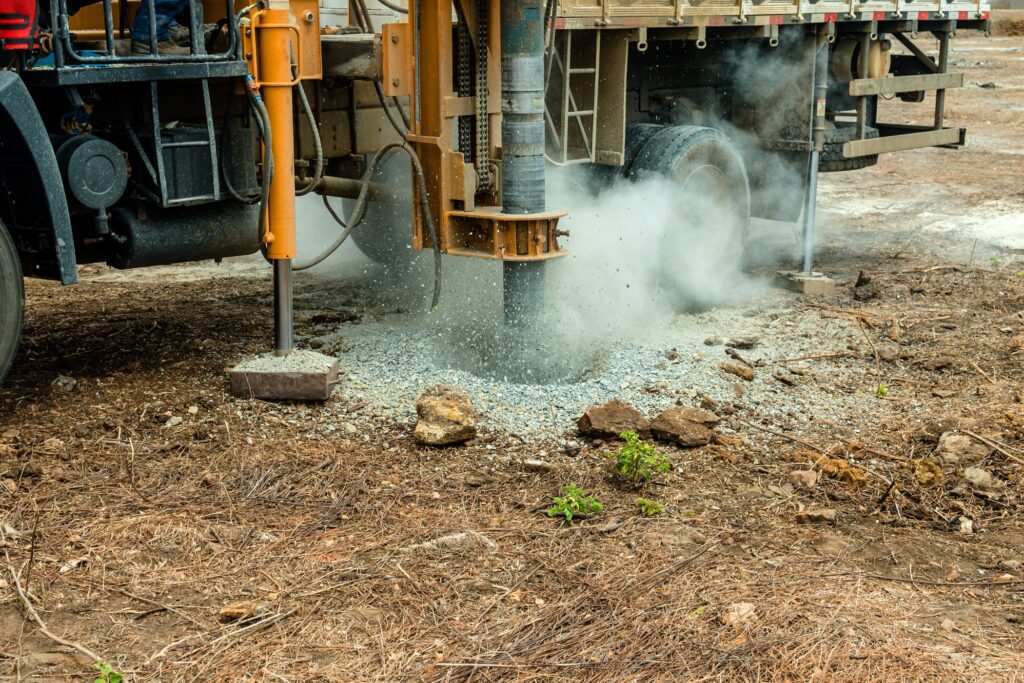
Introduction
Every successful structure begins the same way — with a stable foundation.
That’s the whole game in ground improvement engineering: taking whatever soil Mother Nature gave us and making it behave like a predictable, reliable material.
The objective is simple: understand what’s below the surface, strengthen it when needed, and design systems that keep settlement and distortion within safe limits. Whether the issue is soft clay, loose sand, or miscellaneous fill, the process is always the same — evaluate, design, verify, and monitor.
How Ground Improvement Design Works
1. Understanding the Site
Before any design begins, the ground must be understood.
Site investigations using borings, cone-penetration tests, and sampling define the soil profile and reveal key engineering properties such as strength, density, and permeability.
This is the geotechnical “fingerprint” of a site — and the foundation for every design decision that follows.
2. Identifying the Problems
Field and lab data reveal the challenges: soils that can’t support the loads, excessive settlement potential, poor shear strength, or even liquefaction susceptibility.
Addressing these early prevents costly redesigns and retrofits later in construction.
3. Selecting the Right Technique
The best ground improvement method depends on the soil type, groundwater conditions, structural loads, site access, and budget.
What strengthens sand may not benefit clay — the technique must be tailored to the problem, not applied by habit.
4. Designing and Verifying Performance
Once the method is chosen, the design team integrates it into the foundation system.
Analyses confirm that the improved soil will meet criteria for bearing capacity, settlement, and stiffness compatibility.
Specialty contractors often collaborate during this phase to optimize spacing, geometry, and installation procedures.
5. Quality Control in the Field
During implementation, engineers verify that materials, spacing, and energy input match design intent.
Instrumentation such as settlement plates, inclinometers, and piezometers may be installed to confirm performance.
Timely monitoring and adjustment ensure long-term stability and safety.
Proven Techniques for Soil Stabilization
Mechanical Densification
These methods physically rearrange soil particles to improve density and load-bearing capacity.
- Aggregate Piers / Stone Columns:
A vibrating probe forms compacted columns of aggregate that reinforce the soil mass, provide drainage, and reduce settlement.
- Vibro-Compaction:
In loose sands or gravels, a vibratory lance densifies the soil to mitigate liquefaction and increase stiffness.
- Dynamic and Rapid Impact Compaction:
Both use impact energy to densify fill or shallow soils. Dynamic compaction employs heavy drop weights, while rapid-impact systems use high-frequency hydraulic blows—better suited to vibration-sensitive environments.
- Preloading and Vertical Drains:
Temporary surcharge loads compress soft clays before construction. Prefabricated drains accelerate consolidation by allowing water to escape.
Chemical and Injection Approaches
Instead of moving soil particles, these methods strengthen or seal the ground through binding or replacement.
- Grouting: Pumpable grout fills voids and strengthens weak zones.
- Compaction Grouting: displaces and densifies loose soils.
- Permeation Grouting: injects fluid grout to bond granular soils.
- Jet Grouting: uses high-pressure jets to mix soil and cement in place, creating soil-cement columns or panels.
- Deep Soil Mixing (DSM): Large augers blend cementitious binders into the soil, producing a solid, uniform “soilcrete” mass with controlled strength and permeability.
- Chemical Stabilization: Lime or cement is mixed into clays to reduce plasticity and increase strength—an efficient solution for subgrades and pads.
Design Considerations That Matter
A well-executed ground improvement plan balances performance, constructability, cost, and environmental responsibility.
- Soil Characterization: Accurate data on layering, consistency, and groundwater depth is essential.
- Structural Demands: Each structure has different tolerance for settlement and differential movement.
- Economics: Ground improvement is often more cost-effective than deep foundations or soil replacement.
- Environmental Impact: Some binders and grouts require containment and testing to protect groundwater.
- Construction Constraints: Access limits, vibration sensitivity, or overhead clearances can affect feasibility and equipment choice.
Good engineering is about finding the balance — not over-designing, but designing wisely.
Why Ground Improvement Matters
Ground improvement turns marginal sites into reliable building platforms.
It mitigates settlement, improves safety, and saves both time and cost by avoiding extensive excavation or deep foundation work.
It’s an investment in predictability — ensuring that the structure above performs exactly as intended.
Conclusion
Every project site presents unique challenges.
Through careful investigation, informed design, and precise implementation, weak soils can be transformed into dependable foundations.
Garbin GeoStructural Group provides turn-key geotechnical solutions that merge science, engineering judgment, and practical construction insight — helping clients build smarter from the ground up. Contact us today to see how we can help you.
